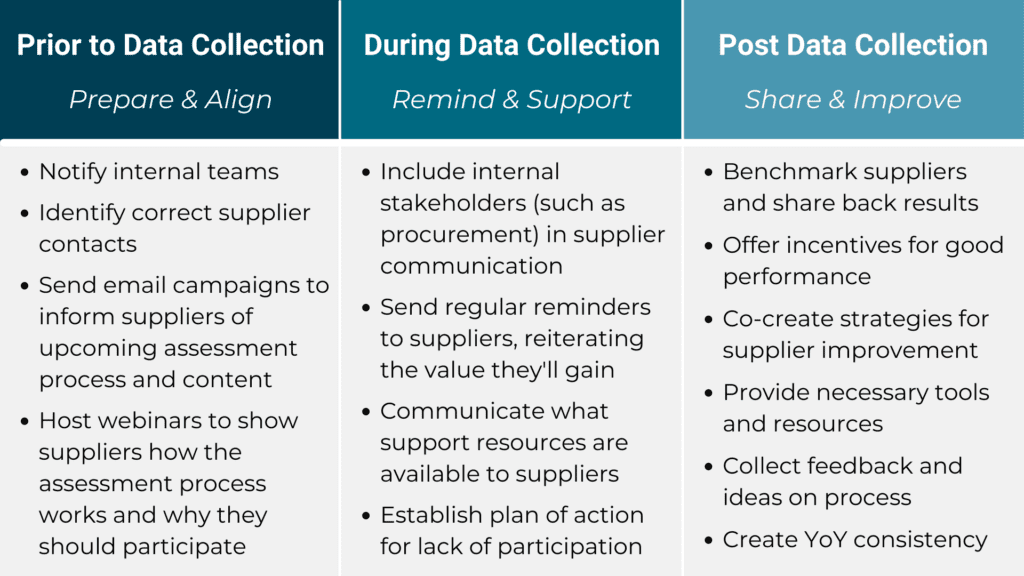The need for supplier engagement has never been greater—an engaged supply chain drives impact and lays the foundation for businesses to collaborate with suppliers to address our most pressing sustainability issues. Yet today, supplier engagement efforts have been lacking.
On September 2nd, we were joined by leaders from Anthesis Group, Anheuser-Busch InBev, and SCS Consulting Services to explore the “whys” and “hows” of supplier engagement, and discuss the challenges businesses are facing in working with their suppliers to create more sustainable supply chains.
Read on for three key takeaways from our webinar, and get answers to some of the questions raised during the audience Q&A period.
Key Takeaways
Supplier Engagement is a Journey
In the context of sustainable supply chains, the term ‘supplier engagement’ is often construed with the process of simply requesting sustainability data from suppliers. However, true “engagement” is much more involved. As Virginia Covo of AB InBev rightly mentioned during the webinar, supplier engagement is a journey.
What do we mean by this? While collecting supplier sustainability data certainly is part of the engagement process and a key first step, it’s not enough to end there. According to our panelists, there are three phases of supplier engagement.
The first is data collection, where businesses inform and prepare suppliers for an upcoming assessment, then collect data from suppliers on relevant sustainability topics. The second phase is analysis, where businesses use the data collected during phase one to uncover sustainability hotspots in their supply chains. The third and final phase is the most important, and is often where companies struggle. This phase involves driving tangible improvement with suppliers, often through co-creation of action plans, capacity building, training programs, incentives, and more.
Put another way, the three phases can be broken down in relation to data collection—prior, during, and post. See the figure below for a quick snapshot of what steps to take along each step of the supplier engagement journey.

As you navigate through these steps, keep in mind that supplier engagement is an iterative, continuous, and collaborative process, not something you do once every few years.
The Importance of Adding Supplier Value
Data collection is often a one-way street, where suppliers are being asked to provide complex data without getting much in return. If your company wants to see real improvement on its goals, your suppliers must be willing to participate.
To do this, you not only need to prepare and support your suppliers during each phase of the supplier engagement journey detailed above, but you should also make the process valuable for them. In other words, just like any good relationship, it has to be a two-way street.
To build these relationships, your suppliers first need to trust the data collection process. As SupplyShift’s Nicole Rhodes mentioned, suppliers often do not know what you’re going to do with their data, and fear that if they answer “incorrectly,” their contract may be jeopardized. Transparency is crucial in this regard. Be sure to explain how their data will be used, emphasizing that their responses will be the foundation for future collaboration and that there will be no punishment for “wrong” answers.
You then should also clearly communicate what incentives are in place for them to improve. “It needs to be the carrot and the stick, not just the stick,” Nicole reiterated. One way to do this is to simply share back your assessment results so your suppliers know where they stand. This is a great way to start a dialogue with your suppliers on what support they may need.
What else can you do? Further exploring the importance of “carrot” versus “stick” incentives in driving improvement, Josh Whitney of Anthesis answers one attendee’s question on what incentives are most effective for suppliers.
“Companies are taking carrot and/or stick approaches to creating incentives for suppliers to participate in these types of programs. I think the most successful programs start first with establishing policies as a matter of practice and a ‘requirement’ to share data and impacts, and then use prioritization and preferential terms as a further incentive to motivate suppliers to take action.”
Remember, the key is that suppliers benefit from the data collection process, and that you’re building meaningful, collaborative relationships instead of just sending data requests. It’s crucial that you show your suppliers what value they’ll gain, whether that’s a better understanding of their performance or financial incentives.
Supplier Engagement is Not One Size Fits All
Suppliers are often at different stages of their sustainability journeys. Some may already be engaging their own suppliers on topics like greenhouse gas emissions, whereas others may not know how or even why they should be keeping track of their emissions.
As Josh recalled from his own experience, a “one size fits all” approach to supplier engagement is not particularly effective—knowing your supplier audience is crucial. According to Josh, supplier engagement strategies should be segmented by supplier maturity, region, size, product category, and/or key impacts.
Of course, supplier engagement strategies will also vary greatly by issue. For instance, with an increasing number of companies creating net-zero commitments, Scope 3 emissions is a pressing concern. One audience member asked if our panelists have ideas on designing supplier engagement programs for Scope 3 specifically, and what businesses can do to help their suppliers reduce emissions.
Anthesis is helping dozens of leading companies do this work right now, particularly in setting science-based targets that require action in the supply chain. Josh provides his insights below.
“Most suppliers need some initial support and tools to efficiently measure and report their footprints as a starting point. For most supply chains, a focus on renewable energy procurement is the most effective pathway to quickly reducing emissions alongside looking for specific efficiency opportunities in their operations. Much harder, but also likely much larger of an impact area, is the supplier’s own supply chain footprint. This requires a longer term investment and roadmap to identify reduction opportunities.”
Anthesis covers all this and more in their just released guide, Activating Supplier Engagement on Scope 3 Emissions. Check that out here.
Final Thoughts
Many thanks to our panelists for lending us their wisdom and providing key lessons from their own experiences. It was a real pleasure to be joined by such a knowledgeable group to discuss the topic of supplier engagement—what works, what doesn’t, and how to drive genuine change with your suppliers.
We look forward to seeing progress on issues like GHG emissions, deforestation, forced labor, and more with initiatives such as AB InBev’s Eclipse program and increased collaboration between brands and suppliers.
Want to watch the full webinar? Catch the recording here, and get in touch with our team to see how we can accelerate your supplier engagement journey.



